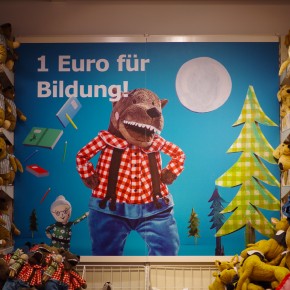Today we’re witnessing the fulfillment of the postmodern condition that figures such as Baudrillard and Lyotard first proclaimed – prematurely – in the 1980s. Abundance, and the simultaneous availability of every kind of cultural commodity threatens to ‘flatten’ out the world, creating a kind of continuous present, beyond progress, beyond history.
What postmodernists never appreciated though, was the fulfillment of their prophecies in a time of prolonged austerity and ecological collapse, a time in which symbolic affluence coexists with material crisis. Indeed, the drift towards virtuality exacerbates material scarcity.
Nor did postmodernists suggest that there might be ways of critically negotiating conditions of abundance. Or that such adaptation may in fact be necessary for the preservation of a variety of important cultural practices, and experiences.
Within this context, we’re witnessing a significant transformation in the nature of music. Scenes act as incubators for identifiable styles and genres, for distinctive ways of being. The slow pace at which they used to be ‘discovered’ by the outside world meant that they had time to develop with a relative degree of isolation. It’s no accident that some of the most distinctive metal styles were initially developed in tightly knit local scenes: Bay Area thrash, Tampa death metal, Norwegian black metal, to name the most obvious examples. Today, the boundaries between them are so porous that distinctive metal scenes are much less coherent than prior decades. Logically, it’s become much harder to ‘map’ metal and to understand its artistic trajectory.
This context seems to be a defining feature of contemporary music. In an interview with Wired in 2012, William Gibson reflected on what the fate of punk would be today:
“You’d pull it up on YouTube, as soon as it was played. It would go up on YouTube among the kazillion other things that went up on YouTube that day. And then how would you find it? How would it become a thing, as we used to say? I think that’s one of the ways in which things are really different today. How can you distinguish your communal new thing — how can that happen? Bohemia used to be self-imposed backwaters of a sort. They were other countries within the landscape of Western industrial civilization. They were countries that most people would never see — mysterious places. You’d pay a price, potentially, for going there. That’s always cool and exciting. Now, where are they? Where can you do that? How are people transacting that today?”
It may be that we’re seeing a significant shift in the role that scenes play within society. In the post-war period, popular music was at the forefront of social change, in pioneering new identities, new ideas and new ways of being. In metal, we can see this in at least two areas. First, local scenes provided a space within which new forms of transgression could be developed and played with. Second, metal scenes (and allied genres such as punk) developed a sophisticated, globalised infrastructure that allowed participants to develop new ways of organising and cooperating.
Nowadays, it’s much less clear that scenes are in the vanguard of social change. Contemporary society is so diverse and so liberalised, at least in the West, that the challenge that popular music represents has become routinized. That isn’t to say that a band like Anal Cunt, for example, is totally acceptable, even within the metal scene. However, that doesn’t mean that metal is the only place where one can find such transgression. Moreover, transgression itself has become more ambiguous as a practice, as standards of acceptable representation have become less clear-cut in a plural world.
Although some forms of extreme metal still retain their power to shock, whole swathes of metal that once had the same effect – think of classic bands like Iron Maiden – rarely attract comment these days. Transgression in metal does not have the power it once had to both attract and alienate listeners.
Music scenes are also no longer the principle sites of social innovation. Enormous growth in technologically-aided entrepreneurship is happening without the need for it as a vehicle. Youth, similarly, no longer require music scenes to create quasi-autonomous global spaces, either.

Of course in non-western societies, particularly those with authoritarian regimes, popular music retains its power to upset and to mobilise. Even here though, it’s no longer the only cultural idiom which people identify with liberation and transgression. For example, although music played a modest role in the 2011 Arab Spring, it was possible to mobilise dissent without it, and there was no particular need to look to music scenes for lessons on how to challenge oppression.
What music scenes seem to be losing is their capacity to act as a kind of vanguard, to prefigure the future and drive us forward to meet it. Instead we seem to have a kind of continuous musical present, in which the boundaries between past and present have become increasingly blurred. This is part of a wider phenomenon that Douglas Rushkoff has termed “present shock.” Today’s ‘always on’ digital world, in which the gap between action and reaction has closed almost to nothing, has radically altered our relationship to time. Narrative history has collapsed into an eternal present, in which we’re flooded by media, sensations and events. Ironically, one of the characteristics of this present is increasing nostalgia and obsession with the past. This is in part because nostalgia looks back to a time when time had more ‘depth’ and music scenes had more apparent substance. As Rushkoff argues:
“When everything is rendered instantly accessible via Google and iTunes, the entirety of culture becomes a single layer deep. The journey disappears, and all of knowledge is brought into the present tense. In the short forever, there is no time to prepare and anticipate. No wonder people hang on to the musical styles and fashions of their youth. Finding them took a kind of time…that is unavailable to cultural explorers today.”
The past now looms large in cultural production. If the speed of change is such that the future is always directly upon us, then the past becomes as valid a source of inspiration as any other period. The past is not gone for ever or discredited; it is part of the now. The half-life of cultural production extends indefinitely, as nothing goes truly out of style, and artists linger well past their sell-by date. (See Mark Fisher’s excellent discussion of this issue, ‘Why Don’t Groups Split Up Anymore?’ in Loops, Issue 2, 2010.)
This is the theme of Simon Reynolds’ 2011 book Retromania, which dissected the ways contemporary pop culture, and popular music above all, has become increasingly obsessed with reworking and resurrecting the past. It is not just that nostalgia has become prevalent – although we can certainly see that in the case of metal, for example, with the continuous stream of re-releases and reunions from even the most insignificant 1980s bands. Nonetheless, the potential of music to surprise, shock and motivate us has been eroded. As Reynolds reflects:
“During the writing of this book I came up with my own glass-half-empty concept to describe the conditions that others gesture at with buzzed-up words like ‘atemporality’ and ‘postproduction’. The term is hyper-stasis. It popped into my head after too many encounters with hotly touted records by new artists that induced a frustrating mix of emotions: feeling impressed by the restless intelligence at work in the music, but missing that sensation of absolute newness, the sorely craved ‘never heard anything like this before.’ Hyper-stasis can apply to particular works by individual artists, but also to entire fields of music. It describes situations in which potent musical intellects engage in a restless shuttling back and forth within a grid-space of influences and sources, striving frenetically to locate exist routes to the beyond.”
Cynics might say that the feeling that Reynolds describes is limited to middle aged critics with a lifetime’s hard-won knowledge of music. It is still likely that when a ten year old in 2013 hears Slayer for the first time, it will be as exhilarating and surprising as it was for a ten year old in 1986. There are still forms of metal that are being developed primarily by and for young people, particularly emo, screamo and djent. But their context is crucially different. Teenage metal in 2013 may offer a new kind of assemblage of metal and non-metal elements. However, it does not provide substantially new sounds. The accumulated weight of over 40 years of metal history looms over new entrants to metal. As nothing in metal history is completely discredited, there is no sense that a new generation can displace the old.
However, while new generations might not come to the fore in the way that they did in metal’s previous history, it’s also true that those who were raised in the digital world – those born since the early 1990s – may understand metal scenes and metal culture very differently to the older generation. Those raised with the instant availability of all kinds of music may well have a broader knowledge of metal and other music, and at the same time may lack the deep knowledge of particular works that was engendered under conditions of scarcity, when the amount of music available was much more limited. It’s unclear at the moment what the impact of this generation gap is and how metal’s new generation might take metal forward. But it’s unlikely that they’ll simply continue the old ways of doing metal.
One possibly ‘game-changing’ development in the evolution of metal is the gradual retirement of metal’s biggest-selling acts*. Black Sabbath may never reunite again after this current round. Iron Maiden and Metallica are likely to last longer, but cannot keep going indefinitely. Judas Priest and Slayer have lost key members. None of this would matter if new generations of bands were taking their place as metal legends and stadium-filling platinum-selling acts, but few bands from the 1990s onwards have the same status and reach.
The likes of Machine Head and Slipknot are still creatively vibrant and extremely popular but as yet they do not have the legendary status that their predecessors did. Again, it is unclear what the impact on metal will be of a scene where the most seminal acts are no longer going concerns. It may be that this will have a liberating effect on younger generations of bands who will have less historical baggage looming over them. On the other hand, it may be that without the unifying effect of mythic acts, metal may dissipate and fragment further.
Whatever the future holds, innovation is still possible in metal. Yet this innovation has been atomised among hundreds of different artists that do not cohere into an overwhelming new direction. We are unlikely to see in metal again the kind of ‘mass extinction event’ that occurred in the early 1990s, that rendered entire genres all but obsolete.
So, while the crisis of abundance is impacting on the entirety of popular music, there are reasons to think that it will effect metal scenes differently. Its long history, and the considerable diversity metal harbors, render it particularly vulnerable to the stasis brought about by an age of affluence. Scarcity, and the historical periodising it brings about, has been an important counterweight to, on the one hand, metal being dominated by a handful of ‘dinosaurs’, and, on the other, its diversity fragmenting it. Yet, the balance metal has long achieved between change and stability, between homogeneity and heterogeneity, is seriously threatened by this brave new world.
Notes:
* I’m grateful to Deena Weinstein for raising the issues discussed in this paragraph.
Part three in a series. Photographs courtesy of Frenk Tetrenky and Doctor Grondo. Published under a Creative Commons license.





